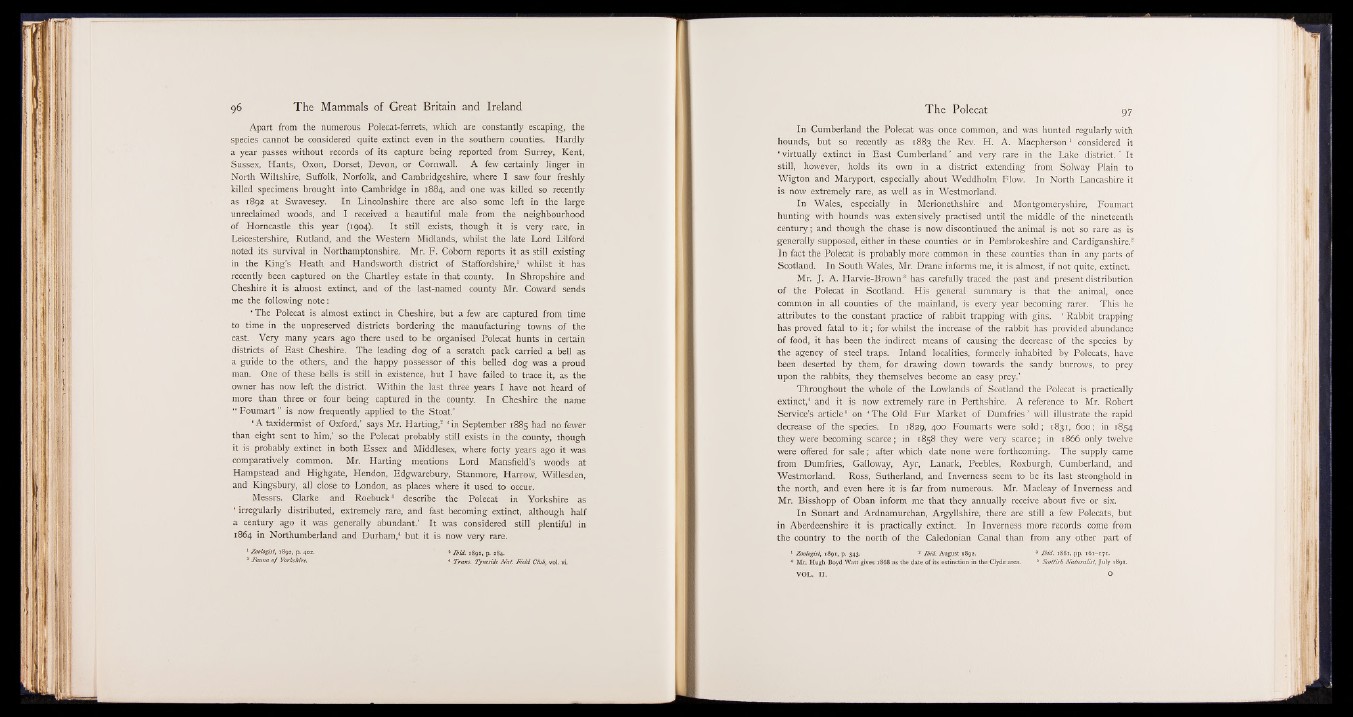
Apart from the numerous Polecat-ferrets, which are constantly escaping, the
species cannot be considered quite extinct even in the southern counties. Hardly
a year passes without records of its capture being reported from Surrey, Kent,
Sussex, Hants, Oxon, Dorset, Devon, or Cornwall. A few certainly linger in
North Wiltshire, Suffolk, Norfolk, and Cambridgeshire, where I saw four freshly
killed specimens brought into Cambridge in 1884, and one was killed so recently
as 1892 at Swavesey. In Lincolnshire there are also some left in the large
unreclaimed woods, and I received a beautiful male from the neighbourhood
of Horncastle this year (1904). It still exists, though it is very rare, in
Leicestershire, Rutland, and the Western Midlands, whilst the late Lord Lilford
noted its survival in Northamptonshire. Mr. F . Coborn reports it as still existing
in the King’s Heath and Handsworth district of Staffordshire,1 whilst it has
recently been captured on the Chartley estate in that county. In Shropshire and
Cheshire it is almost extinct, and of the last-named county Mr. Coward sends
me the following note:
‘ The Polecat is almost extinct in Cheshire, but a few are captured from time
to time in the unpreserved districts bordering the manufacturing’ towns of the
east. Very many years ago there used to be organised Polecat hunts in certain
districts of East Cheshire. The leading dog of a scratch pack carried a bell as
a guide to the others, and the happy possessor of this belled dog was a proud
man. One of these bells is still in existence* but I have failed to trace it, as the
owner has now left the district. Within the last three years I have not heard of
more than three or four being captured in the county. In Cheshire the name
“ Foumart ” is now frequently applied to the Stoat.’
‘ A taxidermist of Oxford,’ says Mr. Harting,2 ‘ in September 1885 had no fewer
than eight sent to him,’ so the Polecat probably still exists in the county, though
it is probably extinct in both Essex and Middlesex, where forty years ago it was
comparatively common. Mr. Harting mentions Lord Mansfield’s woods at
Hampstead and Highgate, Hendon, Edgwarebury, Stanmore, Harrow, Willesden,
and Kingsbury, all close to London, as places where it used to occur.
Messrs. Clarke and Roebuck3 describe the Polecat in Yorkshire as
i irregularly distributed, extremely rare, and fast becoming extinct, although half
a century ago it was generally abundant.’ It was considered still plentiful in
1864 in Northumberland and Durham,4 but it is now very rare.
1 Zoologist, 1892, p. 402.
* Fauna of Yorkshire.
2 Ibid. 1891, p. 284.
4 Trans. Tyneside Nat. Field Club, vol. vi.
In Cumberland the Polecat was once common, and was hunted regularly with
hounds, but so recently as 1883 the Rev. H. A. Macpherson1 considered it
‘ virtually extinct in East Cumberland’ and very rare in the Lake district. * It
still, however, holds its own in a district extending from Solway Plain to
Wigton and Maryport, especially about Weddholm Flow. In North Lancashire it
is now extremely rare, as well as in Westmorland.
In Wales, especially in Merionethshire and Montgomeryshire, Foumart
hunting with hounds was extensively practised until the middle of the nineteenth
century; and though the chase is now discontinued the animal is not so rare as is
generally supposed, either in these counties or in Pembrokeshire and Cardiganshire.2
In fact the Polecat is probably more common in these counties than in any parts of
Scotland. In South Wales, Mr. Drane informs me, it is almost, if not quite, extinct.
Mr. J . A. Harvie-Brown3 has carefully traced the past and present distribution
of the Polecat in Scotland. His general summary is that the* animal, once
common in all counties of the mainland, is every year becoming rarer. This he
attributes to the constant practice of rabbit trapping with gins. ‘ Rabbit trapping
has proved fatal to i t ; for whilst the increase of the rabbit has provided abundance
of food, it has been the indirect means of causing the decrease of the species by
the agency of steel traps. Inland localities, formerly inhabited by Polecats, have
been deserted by them, for drawing down towards the sandy burrows, to prey
upon the rabbits, they themselves become an easy prey.’
Throughout the whole of the Lowlands of Scotland the Polecat is practically
extinct,4 and it is now extremely rare in Perthshire. A reference to Mr. Robert
Service’s article5 on ‘ The Old Fur Market of Dumfries ’ will illustrate the rapid
decrease of the species. In 1829, 400 Foumarts were sold ; 183 1, 600; in 1854
they were becoming scarce; in 1858 they were very scarce; in 1866 only twelve
were offered for sale ; after which date none were forthcoming. The supply came
from Dumfries, Galloway, Ayr, Lanark, Peebles, Roxburgh, Cumberland, and
Westmorland. Ross, Sutherland, and Inverness seem to be its last stronghold in
the north, and even here it is far from numerous. Mr. Macleay of Inverness and
Mr. Bisshopp of Oban inform me that they annually receive about five or six.
In Sunart and Ardnamurchan, Argyllshire, there are still a few Polecats, but
in Aberdeenshire it is practically extinct. In Inverness more records come from
the country to the north of the Caledonian Canal than from any other part of
1 Zoologist, 1891, p. 343. 2 Ibid. August 1892. 3 Ibid. 1881, pp. 161-171.
4 Mr. Hugh Boyd Watt gives 1868 as the date of its extinction in the Clyde area. 5 Scottish Naturalist, July 1891.
VOL. II.